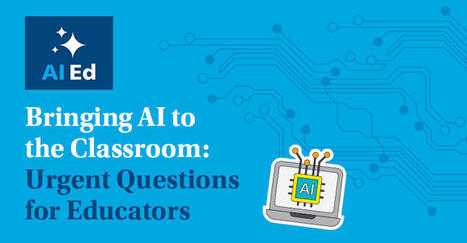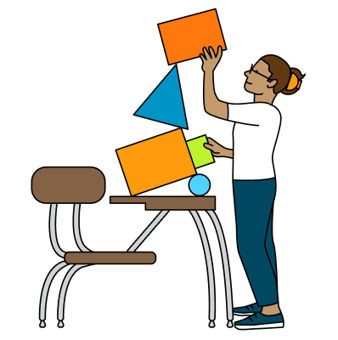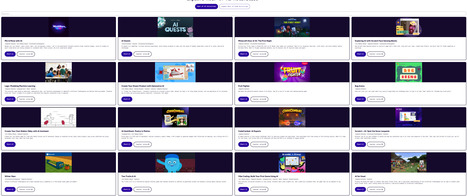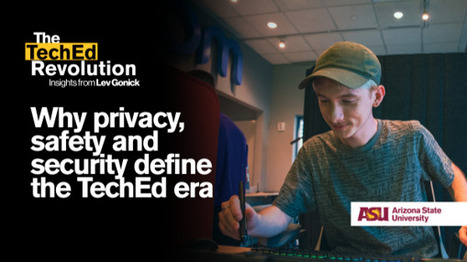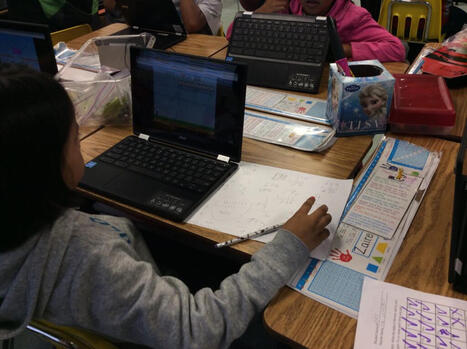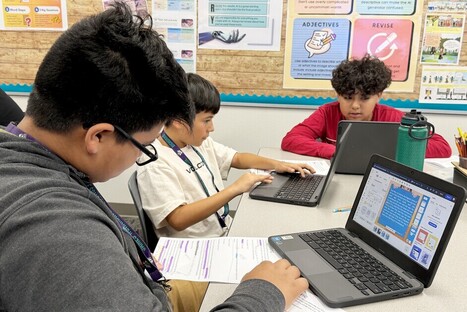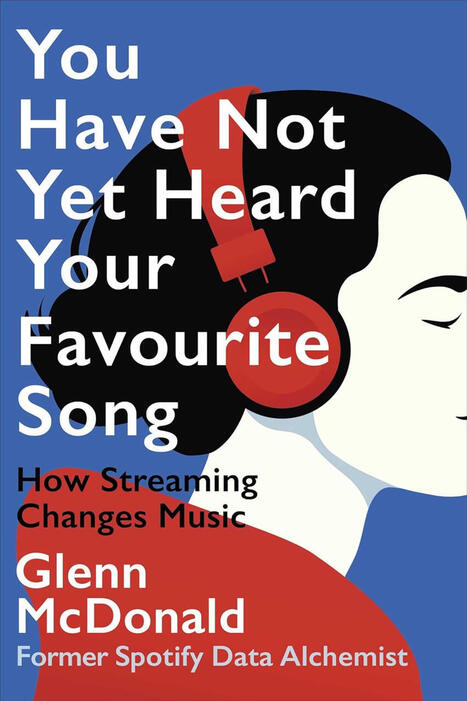
|
Rescooped by
Yashy Tohsaku
from Digital Delights - Digital Tribes
onto Education 2.0 & 3.0 November 13, 5:39 PM
|
Get Started for FREE
Sign up with Facebook Sign up with X
I don't have a Facebook or a X account

 Your new post is loading... Your new post is loading...
 Your new post is loading... Your new post is loading...
ChatGPT can be used as a tool to bring AI to the Classroom and get better at writing. There are endless possibilities to use classroom AI for lessons
Now in 2025, with the rise of AI innovation and large language models, we are no longer building the plane while flying it; the plane is self-built, self-flying
Teachers can use Google Docs in the secondary classroom to facilitate student collaboration and support multimodal learning.
Explore free Hour of AI activities. From lessons to hands-on projects, anyone can dive into AI learning with fun, accessible experiences. Via Dr. Tom D'Amico (@TDOttawa) 
Dr. Tom D'Amico (@TDOttawa) 's curator insight,
November 12, 12:41 PM
Hour of AI Activities - Over 100 free classroom AI learning activities via Hour of AI (Code.org & CSforAll) #ai #hourOfAI #aiLiteracy #aiLeadership
From
www
Innovating Your L&D Strategy By Fostering Agility Imagine a company where Learning and Development (L&D) design is swift, training materials are always up to date, and outdated content and formats are addressed before they negatively affect learning outcomes. This is not a science fiction scenario, Via Vladimir Kukharenko
AI is rapidly transforming classrooms, yet without a coherent framework connecting AI, EdTech, and neuroscience, there are significant risks. Via EDTECH@UTRGV 
EDTECH@UTRGV's curator insight,
Today, 11:47 AM
"Without a coherent approach that connects neuroscience with EdTech and AI, we risk designing systems that optimize for short-term technological efficiency and long-term human problems."
A comprehensive guide to the skills, trends, and strategic shifts to master for successful Instructional Design in 2026. Via EDTECH@UTRGV 
EDTECH@UTRGV's curator insight,
Today, 11:46 AM
"For Instructional Design in 2026, data analytics has become an indispensable tool for creating impactful learning experiences, and the field is experiencing explosive growth."
From
www
The future belongs to students who can ask better questions, verify answers, and flex their thinking.
Teachers can use Google Docs in the secondary classroom to facilitate student collaboration and support multimodal learning.
Kiana sat at her desk, multiple browser tabs open — one for scholarships, one for mental health, one forass registration and not a single one that remembered her.
Later, outside the advising office, she scrolled through her phone, hunting for the exact words she'd used in her last intake form because she knew she’d have to say it all again.
She was told AI could help. But when she tried it, she hesitated. Could she upload a transcript? Would her questions be saved? Could someone else see them? She wanted AI to work for her, but she didn’t know if it was safe to trust it.
Trust, it turns out, was earned not just when AI gave a helpful answer, but when the university treated her data as a bridge to her goals. The real measure was whether the system respected her boundaries, protected her privacy and upheld her right to learn without fear.
And in that moment, the future of TechEd came into focus: the platforms we build will only serve students if they are designed to be worthy of their trust. Via Chuck Sherwood, Former Senior Associate, TeleDimensions, Inc
School leaders must decide how — and whether — to integrate artificial intelligence-specific lessons into computer science programs. Via EDTECH@UTRGV 
EDTECH@UTRGV's curator insight,
November 13, 12:38 PM
"The rapid growth of generative artificial intelligence (GenAI) is creating a new digital divide in K–12 education, an AI skills gap that threatens to leave some students behind."
Chatbots can be great tools for generating travel itineraries. This included ChatGPT, Deepseek, Gemini, Copilot and Claude.
|
To understand how my AI post of a friendly bear could trick anyone, we have to travel back to Halloween night in 1938. On that evening, Orson Welles directed
From
edsource
Discover the importance of AI literacy and computer science education in preparing students for an AI-driven future. Join the mission to empower creators, not just users, of AI.
With growing pressure to reduce emissions, costs and waste, now is the time for universities to reimagine their role in the resource life cycle, says Darren Wilkinson Via Vladimir Kukharenko
A Definition of the ancient Greek term Eudaimonia, sometimes translated as happiness, flourishing, or the good life, as well as views from the Stoics, Epicureans, Cyrenaics and Aristotle on what the good life meant. Via Ana Cristina Pratas
From
www
Artificial intelligence has accelerated the Wright’s Law principle. It is rewriting it, which assumes that experience follows production: You make mistakes, learn from them and improve. AI makes it possible for experience to come before production. Simulation can happen millions of times before a single box is shipped. Experience scales almost instantly at no real cost. The learning curve doesn’t only steepen. It collapses. Via Edumorfosis 
Edumorfosis's curator insight,
Today, 11:07 AM
La Ley de Wright que postula la Curva de Aprendizaje, está colapsando por la proliferación de la IA. Esto significa que el conocimiento que alguna vez tomó décadas de prueba y error humano, ya está surgiendo en semanas, días e incluso horas. El resultado es aún más poderoso cuando la IA se combina con robótica, sensores, inteligencia geoespacial y computación en la nube. Cuando el conocimiento de la IA se infunde con la experiencia de profesionales experimentados, los ciclos de innovación colapsan aún más. El conocimiento se materializará instantáneamente. La innovación y la disrupción llegarán en ondas de choque, no en ciclos. El desafío no será construir las herramientas, sino sobrevivir al ritmo de sus consecuencias.
A comprehensive guide to the skills, trends, and strategic shifts to master for successful Instructional Design in 2026. Via EDTECH@UTRGV 
EDTECH@UTRGV's curator insight,
Today, 11:46 AM
"For Instructional Design in 2026, data analytics has become an indispensable tool for creating impactful learning experiences, and the field is experiencing explosive growth."
Small but intentional practices keep humans at the center of the critical thinking process and turn AI into a gym for the mind. Via EDTECH@UTRGV 
EDTECH@UTRGV's curator insight,
Today, 11:44 AM
"The most powerful way to use AI is to treat it as a partner that widens the field of ideas while leaving the final call to us. AI can collect data in seconds, sketch multiple paths forward, and expose us to perspectives we might never consider on our own."
From
www
Students learn how to write AI prompts while demonstrating reading comprehension in this middle school classroom.
A Chicago freelance journalist said he did not fact-check information he compiled using AI before including it in stories for media clients.
"When ChatGPT-3.5 was released in November of 2022, it was immediately clear that education would change forever. It sparked dramatic headlines speculating the effect of the program on higher education, such as “The College Essay Is Dead” from The Atlantic, and opened a world of untapped possibilities for cheating, plagiarism and rampant misinformation that educators were left to restrain. It’s been a few years since the initial launch of ChatGPT, and the advances in subsequent versions show that ChatGPT’s developers have not lost any ambition." Via EDTECH@UTRGV 
EDTECH@UTRGV's curator insight,
November 13, 12:36 PM
"Given that AI will only become more prevalent in our lives, universities should be taking more formal steps to make sure graduating students are literate in the practical uses of AI and leave college with a well-rounded understanding of the ethical issues surrounding it."
Printers may not be glamorous, but they are an often-overlooked attack vector that should be part of every district's cybersecurity strategy. Via EDTECH@UTRGV 
EDTECH@UTRGV's curator insight,
November 13, 12:41 PM
"Cyber attacks are hitting K–12 schools with alarming regularity. From mid-2023 through 2024, more than four out of five reporting districts faced some kind of breach, such as ransomware, stolen data, or network lockouts. And still, one part of the network gets little attention: the printers." |




